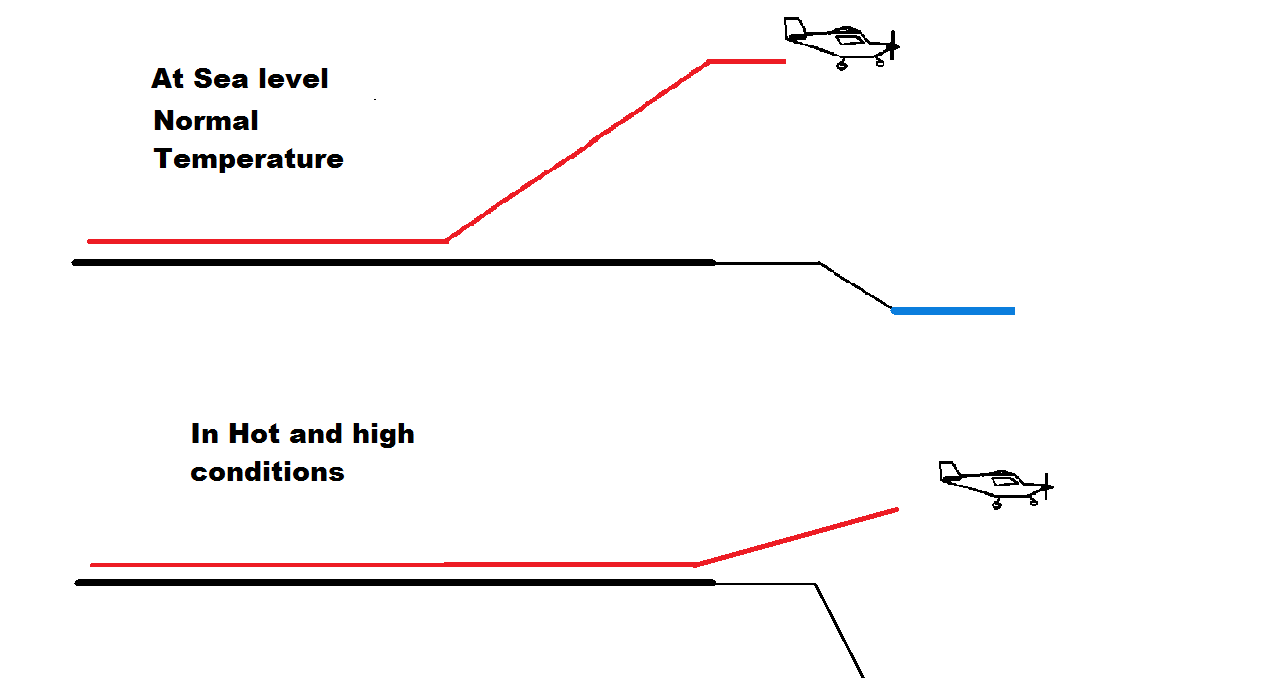|
Outside Air Temperature
In aviation terminology, the outside air temperature (OAT) or static air temperature (SAT) refers to the temperature of the air around an aircraft, but unaffected by the passage of the aircraft through it. Aviation usage The outside air temperature is used in many calculations pertaining to flight planning, some of them being takeoff performance, density altitude, cruise performance and go-around performance. In most texts, the abbreviation, "OAT" is used. Units Most performance and flight planning graphs and tables use either degrees Celsius or Fahrenheit or both. The Kelvin scale, however, is used for Mach number calculations. For example, the speed of sound in dry air is := 38.945 \sqrt, where: :c is the speed of sound in knots, :K is the outside air temperature in kelvins. Sources Outside air temperature can be obtained from the aviation meteorological services, on the ATIS or measured by a probe on the aircraft. When measured by the airplane's probe in flight, it may h ... [...More Info...] [...Related Items...] OR: [Wikipedia] [Google] [Baidu] |
Aviation
Aviation includes the activities surrounding mechanical flight and the aircraft industry. ''Aircraft'' include fixed-wing and rotary-wing types, morphable wings, wing-less lifting bodies, as well as lighter-than-air aircraft such as hot air balloons and airships. Aviation began in the 18th century with the development of the hot air balloon, an apparatus capable of atmospheric displacement through buoyancy. Clément Ader built the "Ader Éole" in France and made an uncontrolled, powered hop in 1890. This was the first powered aircraft, although it did not achieve controlled flight. Some of the most significant advancements in aviation technology came with the controlled gliding flying of Otto Lilienthal in 1896. A major leap followed with the construction of the '' Wright Flyer'', the first powered airplane by the Wright brothers in the early 1900s. Since that time, aviation has been technologically revolutionized by the introduction of the jet engine which enabl ... [...More Info...] [...Related Items...] OR: [Wikipedia] [Google] [Baidu] |
Knot (unit)
The knot () is a unit of speed equal to one nautical mile per hour, exactly (approximately or ). The ISO standard symbol for the knot is kn. The same symbol is preferred by the Institute of Electrical and Electronics Engineers ( IEEE), while kt is also common, especially in aviation, where it is the form recommended by the International Civil Aviation Organization ( ICAO). The knot is a non- SI unit. The knot is used in meteorology, and in maritime and air navigation. A vessel travelling at 1 knot along a meridian travels approximately one minute of geographic latitude in one hour. Definitions ;1 international knot = :1 nautical mile per hour (by definition), : (exactly), : (approximately), : (approximately), : (approximately) : (approximately). The length of the internationally agreed nautical mile is . The US adopted the international definition in 1954, having previously used the US nautical mile (). The UK adopted the international nautical mile defi ... [...More Info...] [...Related Items...] OR: [Wikipedia] [Google] [Baidu] |
Hot And High
In aviation, hot and high is a condition of low air density due to high ambient temperature and high airport elevation. Air density decreases with increasing temperature and altitude. The lower air density reduces the power output from an aircraft's engine and also requires a higher true airspeed before the aircraft can become airborne. Aviators gauge air density by calculating the density altitude. An airport may be especially hot ''or'' high, without the other condition being present. Temperature and pressure altitude can change from one hour to the next. The fact that temperature generally decreases as altitude increases mitigates the "hot and high" effect to a small extent. Negative effects of reduced engine power due to hot and high conditions * Airplanes require a longer takeoff run, potentially exceeding the amount of available runway. * Reduced take-off power hampers an aircraft's ability to climb. In some cases, an aircraft may be unable to climb rapidly enough to cl ... [...More Info...] [...Related Items...] OR: [Wikipedia] [Google] [Baidu] |
Acronyms And Abbreviations In Avionics
Below are abbreviations used in aviation, avionics, aerospace, and aeronautics. A B C D E F G H I J K L M N N numbers (turbines) O P Q R S T U V V speeds W X Y Z See also * List of aviation mnemonics * Avionics * Glossary of Russian and USSR aviation acronyms * Glossary of gliding and soaring * Appendix:Glossary of aviation, aerospace, and aeronautics – Wiktionary References SourcesAerospace acronymsTerms and GlossaryAviada Terminaro verkita de Gilbert R. LEDON, 286 pagxoj. External links Acronyms used by EASAAcronyms and Abbreviations- FAA Aviation DictionaryAviation Acronyms and AbbreviationsAcronyms search engine by Eurocontrol {{DEFAULTSORT:aviation, avionics, aerospace and aeronautical abbreviations Abbreviations An abbreviation () is a shortened form of a word or phrase, by any method including shortening, contraction, initialism (which includes acronym), or crasis. An abbreviation may be a shorte ... [...More Info...] [...Related Items...] OR: [Wikipedia] [Google] [Baidu] |
Total Air Temperature
In aviation, stagnation temperature is known as total air temperature and is measured by a temperature probe mounted on the surface of the aircraft. The probe is designed to bring the air to rest relative to the aircraft. As the air is brought to rest, kinetic energy is converted to internal energy. The air is compressed and experiences an adiabatic increase in temperature. Therefore, total air temperature is higher than the static (or ambient) air temperature. Total air temperature is an essential input to an air data computer in order to enable the computation of static air temperature and hence true airspeed. The relationship between static and total air temperatures is given by: \frac = where: *T_= static air temperature, SAT (kelvins or degrees Rankine) *T_\mathrm= total air temperature, TAT (kelvins or degrees Rankine) *M_= Mach number *\gamma\ =\, ratio of specific heats, approx 1.400 for dry air In practice, the total air temperature probe will not perfectly recover ... [...More Info...] [...Related Items...] OR: [Wikipedia] [Google] [Baidu] |
Friction
Friction is the force resisting the relative motion of solid surfaces, fluid layers, and material elements sliding against each other. Types of friction include dry, fluid, lubricated, skin, and internal -- an incomplete list. The study of the processes involved is called tribology, and has a history of more than 2000 years. Friction can have dramatic consequences, as illustrated by the use of friction created by rubbing pieces of wood together to start a fire. Another important consequence of many types of friction can be wear, which may lead to performance degradation or damage to components. It is known that frictional energy losses account for about 20% of the total energy expenditure of the world. As briefly discussed later, there are many different contributors to the retarding force in friction, ranging from asperity deformation to the generation of charges and changes in local structure. When two bodies in contact move relative to each other, due to these variou ... [...More Info...] [...Related Items...] OR: [Wikipedia] [Google] [Baidu] |
Sensor
A sensor is often defined as a device that receives and responds to a signal or stimulus. The stimulus is the quantity, property, or condition that is sensed and converted into electrical signal. In the broadest definition, a sensor is a device, module, machine, or subsystem that detects events or changes in its environment and sends the information to other electronics, frequently a computer processor. Sensors are used in everyday objects such as touch-sensitive elevator buttons ( tactile sensor) and lamps which dim or brighten by touching the base, and in innumerable applications of which most people are never aware. With advances in micromachinery and easy-to-use microcontroller platforms, the uses of sensors have expanded beyond the traditional fields of temperature, pressure and flow measurement, for example into MARG sensors. Analog sensors such as potentiometers and force-sensing resistors are still widely used. Their applications include manufacturing and machinery ... [...More Info...] [...Related Items...] OR: [Wikipedia] [Google] [Baidu] |
Automatic Terminal Information Service
Automatic terminal information service, or ATIS, is a continuous broadcast of recorded aeronautical information in busier terminal areas. ATIS broadcasts contain essential information, such as current weather information, active runways, available approaches, and any other information required by the pilots, such as important NOTAMs. Pilots usually listen to an available ATIS broadcast before contacting the local control unit, which reduces the controllers' workload and relieves frequency congestion. ATIS was developed and adopted by the FAA in the mid-1960s and internationally (under the direction of ICAO) beginning in 1974. Before the adoption of ATIS, this information was routinely disseminated to each aircraft separately, increasing controller workload during periods of high traffic density. In the U.S., ATIS will include (in this order): the airport or facility name; a phonetic letter code; time of the latest weather observation in UTC; weather information, consisting of wi ... [...More Info...] [...Related Items...] OR: [Wikipedia] [Google] [Baidu] |
Meteorology
Meteorology is the scientific study of the Earth's atmosphere and short-term atmospheric phenomena (i.e. weather), with a focus on weather forecasting. It has applications in the military, aviation, energy production, transport, agriculture, construction, weather warnings and disaster management. Along with climatology, atmospheric physics and atmospheric chemistry, meteorology forms the broader field of the atmospheric sciences. The interactions between Earth's atmosphere and its oceans (notably El Niño and La Niña) are studied in the interdisciplinary field of hydrometeorology. Other interdisciplinary areas include biometeorology, space weather and planetary meteorology. Marine weather forecasting relates meteorology to maritime and coastal safety, based on atmospheric interactions with large bodies of water. Meteorologists study meteorological phenomena driven by solar radiation, Earth's rotation, ocean currents and other factors. These include everyday ... [...More Info...] [...Related Items...] OR: [Wikipedia] [Google] [Baidu] |
Kelvin
The kelvin (symbol: K) is the base unit for temperature in the International System of Units (SI). The Kelvin scale is an absolute temperature scale that starts at the lowest possible temperature (absolute zero), taken to be 0 K. By definition, the Celsius scale (symbol °C) and the Kelvin scale have the exact same magnitude; that is, a rise of 1 K is equal to a rise of 1 °C and vice versa, and any temperature in degrees Celsius can be converted to kelvin by adding 273.15. The 19th century British scientist Lord Kelvin first developed and proposed the scale. It was often called the "absolute Celsius" scale in the early 20th century. The kelvin was formally added to the International System of Units in 1954, defining 273.16 K to be the triple point of water. The Celsius, Fahrenheit, and Rankine scales were redefined in terms of the Kelvin scale using this definition. The 2019 revision of the SI now defines the kelvin in terms of energy by setting the Bo ... [...More Info...] [...Related Items...] OR: [Wikipedia] [Google] [Baidu] |
Speed Of Sound
The speed of sound is the distance travelled per unit of time by a sound wave as it propagates through an elasticity (solid mechanics), elastic medium. More simply, the speed of sound is how fast vibrations travel. At , the speed of sound in air is about , or in or one mile in . It depends strongly on temperature as well as the medium through which a sound wave is propagating. At , the speed of sound in dry air (sea level 14.7 psi) is about . The speed of sound in an ideal gas depends only on its temperature and composition. The speed has a weak dependence on frequency and pressure in dry air, deviating slightly from ideal behavior. In colloquial speech, ''speed of sound'' refers to the speed of sound waves in Earth's atmosphere, air. However, the speed of sound varies from substance to substance: typically, sound travels most slowly in gases, faster in liquids, and fastest in solids. For example, while sound travels at in air, it travels at in water (almost 4.3 times a ... [...More Info...] [...Related Items...] OR: [Wikipedia] [Google] [Baidu] |







